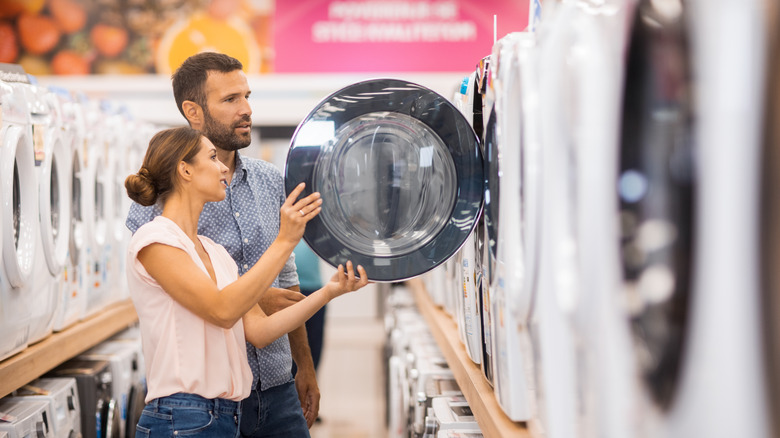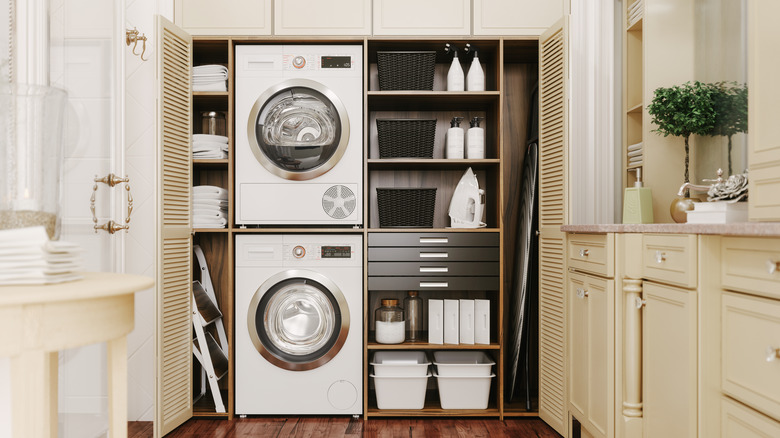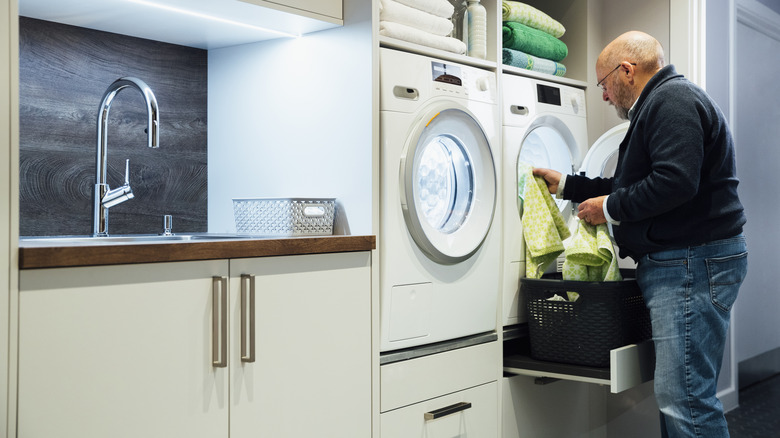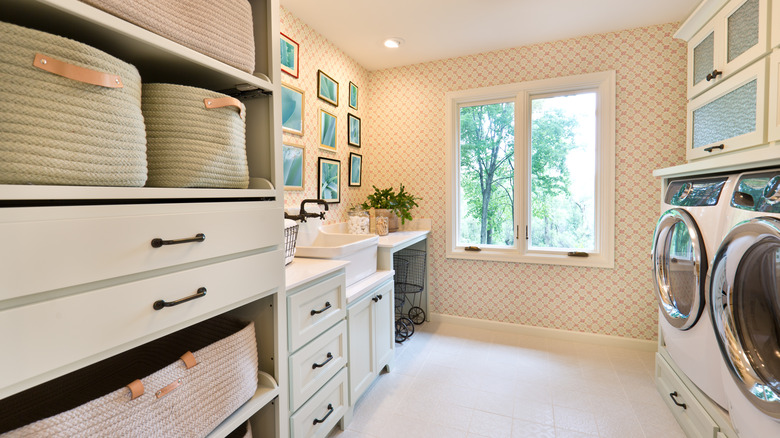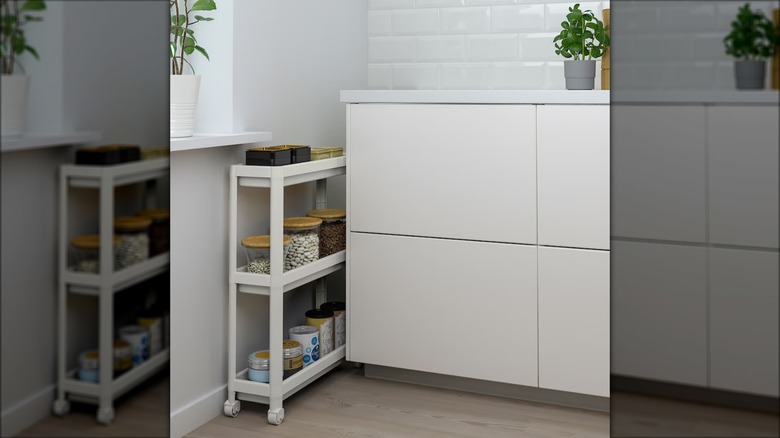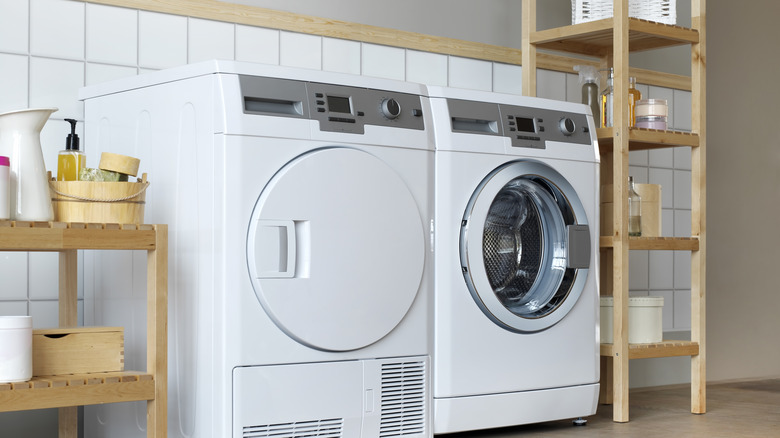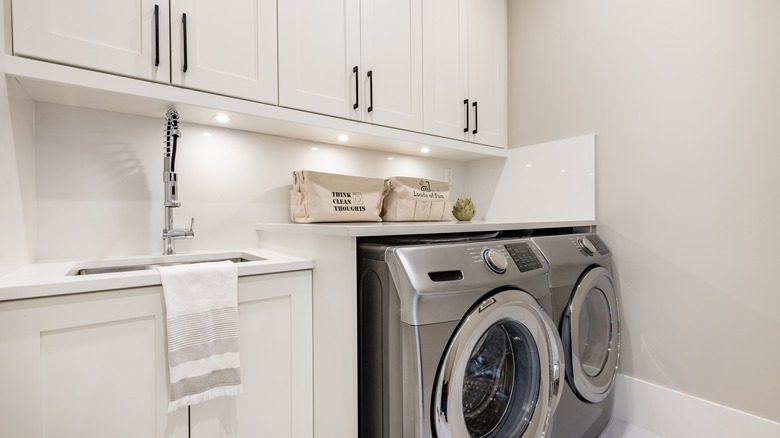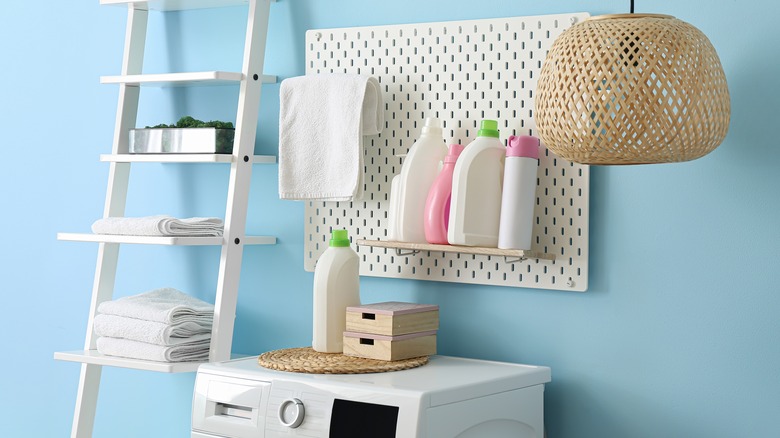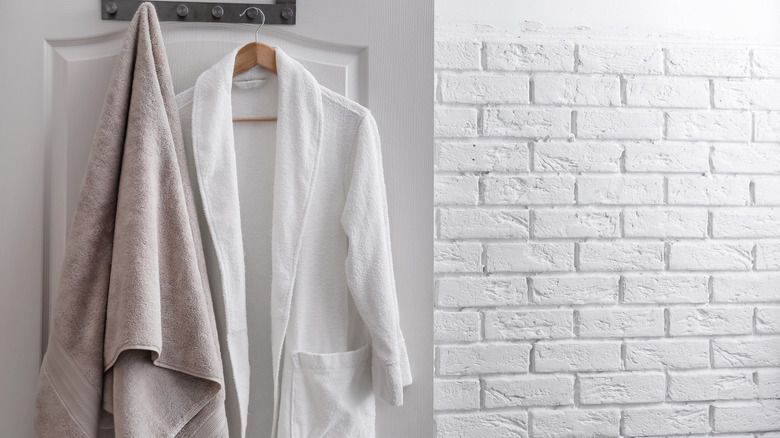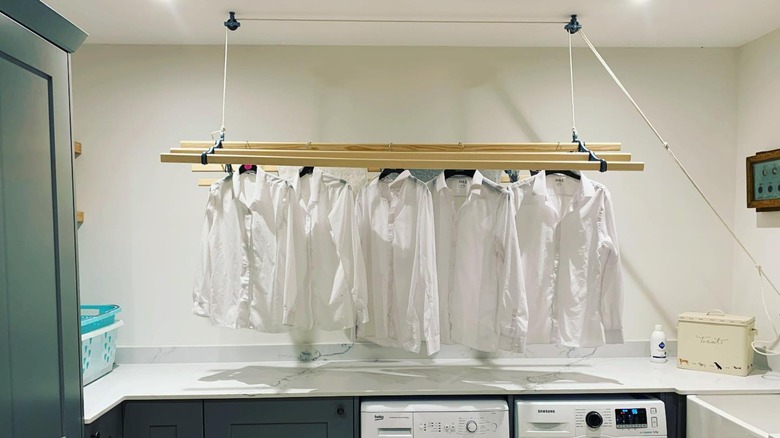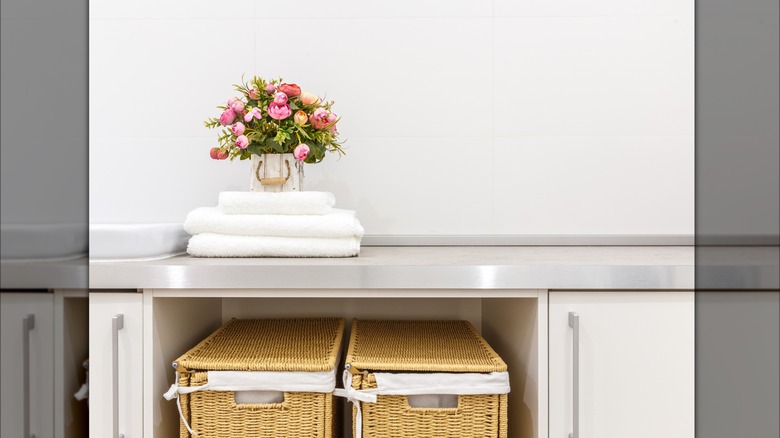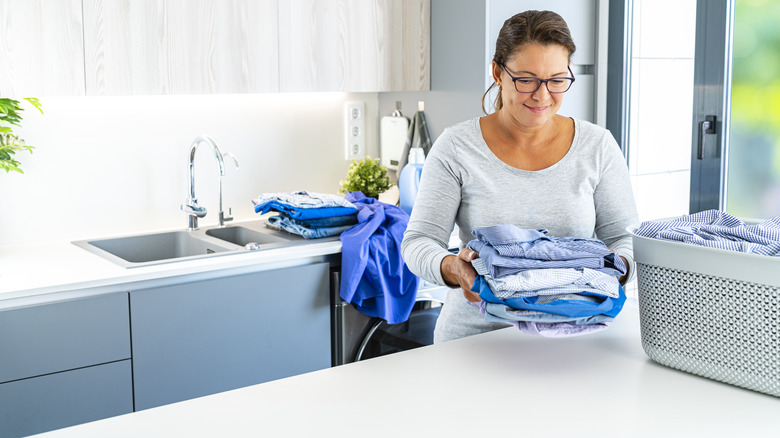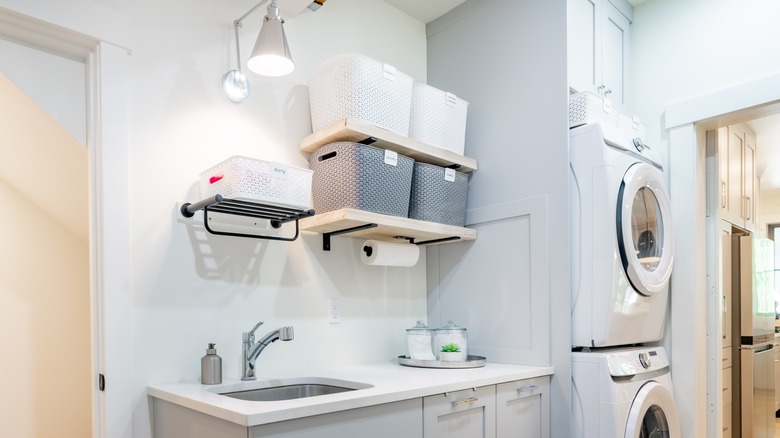Here's How To Create A Functional Laundry Room
We may receive a commission on purchases made from links.
Laundry can feel like a never-ending chore, and you're not just imagining it: the average American does around 300 laundry loads a year (per the US National Parks Service). Since you spend a lot of time in the laundry room, you want to make the space as practical as possible — it might save you some time and stress. The right layout, accessories, and storage can help you streamline the laundry process, maximize space, and create a functional and organized laundry room overall.
A laundry room should be more than just the spot where the washer and dryer live. It's also a place for a range of other cleaning tasks, including separating laundry loads, pretreating items, handwashing delicates, and folding clean garments. Whether it's a laundry closet or a designated laundry room, you'll want to take advantage of your space and its possible uses. No matter how big or small, we've rounded up some ways you can create a functional laundry room to make washing clothes feel like a little bit less of a chore.
Choose the right washing machine
If you're in the market for a new washing machine, you have three types to choose from. There are front-loading and top-loading models as well as two-in-one washer-dryer combos. Your laundry room's layout and your physical preferences can determine the best option for your needs.
For the most part, front-loading washers are the best choice. They tend to be both more efficient and effective cleaners than top-loading washers. However, you need to have space to open their swinging door and some users may not like reaching down that low to get to their laundry (though a pedestal can help with this issue). These machines can also have a reputation for being smelly and prone to mold and mildew, so weigh this potential problem against the washer's cleaning power. In terms of creating a practical laundry room layout, stackable front-loading washers give you the option to stack your washer and dryer — a perk that top-loading machines can't provide. However, if you have a tight laundry room and simply don't have the space for an outward swinging door, a good Energy-efficient top-loading washer will get the job done well.
If you have a tight laundry room or a tight budget, a two-in-one washer-dryer machine might be the right choice. Generally, these machines don't perform as well as their separate counterparts, but they save space, tend to cost less than buying a washer and dryer, not to mention they're convenient (you won't even need to move your laundry load until it's all done and dried).
Consider stacking your washer and dryer
A stacking washer and dryer can cut the used floor space in half — you will only need to consider the footprint of one machine rather than two. This layout is especially useful for laundry closets, taking advantage of vertical space and making room for extra storage alongside the machines. Even if you have a designated laundry room, stacking your machines frees up floor space for other laundry accessories and chores, like a folding table, drying rack, or ironing board.
Not all washers and dryers can stack. Top-loading washing machines aren't an option, and you'll need to find a stackable front-loading washer that's compatible with your dryer (or vice versa). Even if the machines are compatible, you can't just pile them on top of each other and call it a day: if it's not properly secured, this setup can be a major safety hazard. Make sure to install a stacking washer and dryer with a suitable stacking kit or shelving system.
While a stacked laundry system is a huge space saver, it does have some downsides. These washers and dryers can have a smaller capacity. You'll also have fewer options if you choose to replace one of the machines since you'll have to find a model that is compatible with your other machine. If you happen to have a short stature, you may find the top machine difficult to reach.
Or get a laundry pedestal (and choose the right one)
Adding a laundry pedestal puts a front-loading washer and dryer at a more comfortable height. Also known as a washing machine stand, they are about a foot tall and provide an extra bit of height so you don't need to reach as low to do your laundry. It's a small difference, but your back will thank you! You can buy general pedestals or machine-specific pedestals from your washer and dryer brand. Alternatively, you can build your own laundry pedestal fairly easily with planks of wood and a few tools. Laundry pedestals should only be used for side-by-side washer and dryer configurations (never for stacked installations!).
If you choose the right one, a laundry pedestal will provide extra perks as well. Even the simplest pedestals can add extra storage to your laundry room, with space underneath for bins, pull-out drawers, or cabinet doors. Some laundry pedestals have a pull-out ledge where you can place your laundry basket while loading or unloading the machines. Higher-tech laundry pedestals are only compatible with specific washers but can come with interesting perks. For example, some washer brands sell pedestals that hold a bulk amount of detergent inside, which automatically dispenses into the machine with each load. Another product, pedestal washers, are like mini washing machines that let you wash a small laundry load separate from the main washing machine.
Install practical storage
If you have the space, you'll likely use your laundry room to store more than just laundry items. It's a good spot to stash other cleaning accessories and supplies and to store your vacuum cleaner and mop. You can keep items organized and fit a whole lot more in, as long as you have a practical storage setup.
Take advantage of unused space by placing shelving where you can, including beside and above your washer and dryer. Floor-to-ceiling shelving is a good use of space and can be installed around your laundry machines. While open shelving looks modern, if you have a lot of stuff, you might prefer closed shelves or at least organization baskets. They'll hide items and mess better (after all, it's not like most cleaning bottles are aesthetically pleasing). To maximize storage space, you can also choose products that are easy to store, such as folding drying racks, collapsible wash basins, and foldable stools.
Take advantage of movable storage and tight spaces
Since it's more of a utility room than a living space, it makes sense to maximize every bit of storage in your laundry room. Movable storage solutions, like storage carts, let you stock more while allowing flexibility. Unlike fixed shelving, you can move a storage cart to the side if you need extra floor space. Take advantage of small spaces with slim storage carts, like this one from IKEA, which can slide into previously wasted space.
Take inspiration from your local laundromat by using rolling laundry hampers and baskets. These hampers can save your back, especially if you do several loads of laundry a week, by taking away the task of lugging around a heavy basket. Wheeled bins tend to be more expensive than regular hampers (especially for commercial-style versions with four wheels), but they make it easier to transfer items around. If you have the space and budget, they're a worthwhile investment.
Keep most-used items within easy reach
A streamlined laundry process is a more efficient one. Start with keeping your laundry items within close reach of where you need them. Organize your laundry area by section, if you have the space and layout. For example, with a pre-treating station near the utility sink at one end, detergent products close to the washing machine, and dryer sheets next to the dryer. If you don't have the right shelving setup, you can put these frequently used items on a storage cart that you can wheel with you as you go.
A liquid detergent bottle holder like the Smart Design Sud Station is a useful addition to many laundry rooms. It lets you place your detergent bottle on any flat surface, ready to dispense without causing a mess. Consider keeping other laundry-related odds and ends nearby, such as a sewing kit so you'll actually repair garments coming in and out of the wash, rather than putting them aside for later. Keep a basket for those mysteriously single socks as well. It's easier to match stray ones in the laundry room rather than letting them get lost in your sock drawer.
A utility sink is super useful
A laundry room utility sink can be just the right place to tackle all the dirty jobs you don't want to do in the kitchen sink. Often larger, deeper, and more heavy-duty than a kitchen sink, they're built for heavy-duty cleaning tasks. If you don't have one already, you should consider installing one. A freestanding utility sink is often the most cost-effective option, but wall-mounted and drop-in sinks can look more finished. If you have one but rarely take advantage of it because it's not ideal to use (for example, it's too small or it's in a cramped spot), consider upgrading to a new sink.
Ideally, the utility sink should be near the washing machine. If you use it for pre-treating or soaking clothes, this makes transferring loads easier. Utility sinks are useful for a huge range of tasks beyond pre-soaking laundry and hand-washing delicates. You can also use them to clean pet supplies (no one wants to mix the litter box with the dishes!) or even small pets themselves, rinse off shoes or outdoor gear, dump out mop water, and scrub super grimy items. To get even more use of your sink, install a tension rod or hanging bar overhead, which will give you a spot to drip-dry small items without getting the floor wet.
Make use of wall space
When maximizing laundry room storage and organization, don't forget about vertical space. Unused walls (especially over or beside a washer or dryer) are wasted space when you're in need of storage. The obvious solution is to add shelving, but there are other options that may be more practical. If you're short on drying space, install a wall-mounted drying rack, like this Pottery Barn option. A fold-down wall-mounted rack gives you a drying area without having to finagle an unwieldy rack from the closet. Choose an option that is easy to tuck out of the way when you're done.
Other storage solutions include hanging hooks, hanging caddies, and broom holders. Command sells sticky options that won't damage walls, but if you can install proper wall-mounted accessories, that's a better choice. Screwed or nailed-in options will usually have a higher weight limit than their sticky alternatives. There are also a few ways you can get creative with storage in the laundry room. Use a few hooks to create an ironing board hanger. Or for ultimate flexibility, install a pegboard, which you can change the layout of and decorate as you please.
Add more vertical storage
Whether you're a renter or just intimidated by the idea, sometimes it doesn't work to install items on your walls. But that doesn't mean you can't make use of vertical space! There are plenty of alternatives that still let you use vertical areas. For example, instead of a wall-mounted hanging rack, you can opt for an over-the-door rack like the Simple Houseware Over the Door Hanging Rod, which will give you more hanging space without possible wall damage. For organization, an over-the-door shoe holder is a useful pick, providing tons of small pouches for you to toss laundry accessories.
If you don't feel comfortable mounting small shelves and caddies on walls, you can add them to the inside of cabinets and closets, where a bit of peeled paint might be less noticeable. Shelf inserts can add more shelving space for cleaning supplies. Perhaps the most damage-free solution of them all, magnetic shelves and caddies can stick on the side of washers and dryers and are easy to move around and remove.
Hang items from the ceiling too
If you don't have much extra wall space, why not look higher? There are a few ways to take advantage of ceiling space as well. If you hang a lot of your clothes to dry, one way is with a ceiling-mounted drying rack. These tend to be larger than wall-mounted options and can have a convenient pulley system to move them up and out of the way when you're done drying your clothes. A ceiling-mounted or wall-to-wall hanging bar can also provide a spot to hang clothes from hangers.
While some homeowners treat the laundry room as a utility room, many want it to be a calm and decorated part of the house — especially if you spend a lot of time there! Just like any other room, you'll want to use your walls and ceilings for decor. Ceiling-mounted hanging hooks are the perfect place to hang plants, which is an instant mood booster in any room. A decorative yet functional hanging light fixture can give a laundry room more personality, while also providing practical lighting.
Use sorting hampers to organize dirty laundry
Sort your laundry at the first step: the hamper. Pre-sorting your laundry can make laundry day go by much easier. There are products to help, such as the SimpleHouseware 3-Bag Laundry Sorter, which has three labeled laundry bags on wheels. If you want to create your own system, you can do so with different-sized laundry hampers, baskets, or bins. Not each sorting category might need its own whole hamper, for example, if you only own a few delicates, you can sort those into a basket on one of your shelves or in a hanging laundry bag.
The first step in figuring out the right system for your needs is to decide how you prefer to sort your laundry. There are several ways that go beyond just lights and darks. Some people sort loads by the owner to make putting it away easier. Others sort by color like darks and lights or by specific wash cycle types or temperatures. You can also sort loads by category like everyday clothes, denim items, bath towels, and kitchen linens. You likely use a combination of these laundry sorting strategies. The end goal is to be able to toss everything in the hamper into the washing machine for one load, so sort with this in mind.
Add a folding table
A folding table can make folding clean laundry feel like less of a chore. A table keeps items at a comfortable height, and since you're standing, it makes it easier to maneuver garments around. Once you've used a folding table, you'll notice how much easier it is than folding clothes on the couch! There are several options to choose from depending on your laundry room space and layout. If you have the room, a standalone folding table and a multi-purpose workspace for cleaning, and crafting tasks.
Another popular layout is a tabletop over two front-loading machines, which lets you add a work area without taking up floor space. This setup can also make it easier to hide your washer and dryer; you can install a curtain or a cabinet door to cover your machines. If you're extra tight on space, one last option is a wall-mounted table that can fold out of the way when it's not in use.
Use baskets, trays, and bins to keep clutter to a minimum
It's no storage secret, but it's always worth the reminder. Containers can keep clutter to a minimum, and less clutter means a more organized and efficient laundry room. If you have open shelving, you'll definitely want to take advantage of decorative bins to keep appearances neat. A useful addition to any laundry room is a catch-all container, where you can put loose change, lip balms, and other items you find inside pockets. If your family member is missing a small item, they'll know the first place to check. Use other containers to organize small items, and consider labeling them so they're easier to navigate. With plenty of decorative container options, you don't need to settle with plain plastic baskets. Glass jars, wicker bins, and fabric baskets can get the job done, and look much nicer while doing so.
If you have the space, make use of decorative trays on top of your washer and dryer. Aside from providing a spot to place items, they can also contain liquid and powder spills from your laundry detergent, and they'll make your laundry room look more put-together as well.

